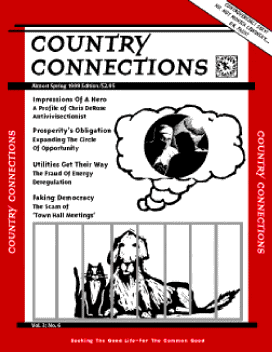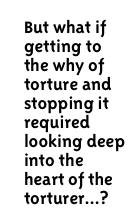 |
||||||||||||
 |
||||||||||||
MET AN ANIMAL RIGHTS TERRORIST RECENTLY? How about a fanatic or a kook? Or has it been your good fortune to have coffee and conversation with a hero recently? Chris DeRose, antivivisectionist and founder of Last Chance For Animals, has been called all those and a few other names as well. He's been chased, spat on, arrested, shot in the back and has done jail time. He's also done extraordinary work for animals. If you believe vivisection is immoral, you'll call Chris a hero. If you worship in the church of scientism, you'll think he's a nut and a terrorist. And doesn't love the U.S. of A or his mom. Vivisection—the act of cutting into or otherwise injuring living animals for the purpose of scientific research—is a subject we like to avoid. Too emotional. People are too passionate about it. Any compassion felt for the animals being cut, poisoned, burned, or purposefully driven crazy runs counter to our need to genuflect at the altar of science. Too bad; we might have to talk about it here, and lest there be any confusion about our own position: we think vivisection immoral and any benefit (arguable) derived from it thus tainted. We also think that scientists who perform it are immoral and in a better world would be thought criminal—no matter the accolades, Nobels, grants, perks, awards luncheons, and general blind worship by a public who currently believes almost anything as long as the packaging is authoritarian. Before you leave the room or before we speak more of Chris would you please remember an animal you happened to love beyond measure? There are some names that come to mind at this end of our conversation. Please feel free to supply your own, but we know of: Klondike, T.S, Tatiana, Mick, Gabe, Piri, Little John, Sheba, Freddy, Joanna, Alex, Colin, Gus, Bridget and Kaboodle. Each currently loved or greatly mourned. Now, for purposes of our experiment, take away their names and thus our protection of them and substitute, for each of the named creatures, cage numbers and the following descriptive placards: "Induced Ulcer," "Induced Cancer," "Maternal deprivation," "Hypothermia," "Sleep Deprivation," "Sensory Deprivation," etc. Put another way, "Cats 1 through 11, dogs 1 through 4, sacrificed in the name of science. Experiments successful." Remember, those fifteen creatures were ours, and they had our love. Yes, and rats and mice and rabbits. And tens of thousands of other cats and dogs—stray, abandoned, stolen—all of whom might have had names if enough of us had gotten to the shelter in time. Is our naming them all that can engage our moral sense and elicit our protection?
Chris DeRose doesn't think so and bets his life on it. But fashions in the world of animal activism change and recently food animals have been getting the attention. Chris has written an important book, In Your Face: From Actor To Animal Activist, and in a conversation with an old friend about the book and his work, Chris tries to explain why But you also believe there is something else, something he is thinking but isn't telling you about his understanding of vivisection. As if after all these years in the antivivisection movement he has come to understand what he is really dealing with, and further understands that his insights are perhaps just too complex and dark to reveal—even in an interview with an old compatriot. Activists aren't always comfortable with introspection, and many have insights that aren't for public consumption. Chris calls what we do to animals torture and leaves it at that as to why it must be stopped. But what if getting to the why of torture and stopping it required looking deep into the heart of the torturer, and what if we were all somehow complicit—even those of us who deplore vivisection and think of ourselves as animal lovers? What if in dealing with vivisection we had to begin to deal with an acceptance of something in all of us? What if after scaling so many walls and being handcuffed so many times, Chris has come to understand that something in the human heart needs accepting? It might be the last thing an activist is comfortable talking about. After all the action. But vivisection, if you think about it, is so dark, so offensive to the best in us, that one who has dealt with it for as long as Chris has, must have a way of explaining it on a level as deep as its horror. For sanity's sake. The following is conjecture, a compatriot's speculation, but his understanding might be like...
We have worried what clangs and rages under our neocortex, the most evolved part of our brain, since coming so pridefully out of the trees. It's the thing that does not fit our godliness. Something is under there, under our superiority; and it's not The Rational. We call it our darkness because we can't see it to control it—it won't line up under our constructs. We can't call it God and have gotten used to calling it hell. It's that which we can't control with our rational mind—the apotheosis of which we call God. It's that other thing. Goddamn that other thing, that shadow, all our dark thoughts; there must be a way of getting a handle on that, getting it in line. It's so troubling otherwise; it interferes so with our godliness. Let's call it Animal. Along with psychoanalysis, voodoo, Santeria, astrology, the casting of bones and augury, what if vivisection, our strapping that cat into the stereotaxic device and disemboweling the dog, was more than anything else an attempted act of human definition, of separating to understand, even of amelioration? What if a transformative alchemy was intended in the act of vivisection, a sacrifice of The Irrational, a cleansing? No matter the anesthetic that the vivisector claims desensitizes the animal to any pain for the "important and necessary research," there is one act that must remain sensate, and that is the singular act where the animal is selected from his cage and controlled before the anesthesia. That act of control is the true Act of Vivisection. We strap the experimental subject down—not for some vaunted scientific examination or to elicit some forever promised cure—but to separate and examine and control something we don't understand—in us. In us. It's that raging thing that clangs under the neocortex that we call The Animal. Vivisection is introspection made manifest. We want to know what struggles, what is making all the noise under the Rational Mind. What is getting in the way of our godliness? Look there, on the table. Our madness identified, controlled, transformed, and finally—as the vivisectors say—sacrificed.
None of this works on a flyer. Or in a pitch for funds. It's more like some strange theology. It smells of nutsiness and fanaticism and being thought fanatical is what those who believe that vivisection is horrific want to avoid. It's lousy for PR. It doesn't work for a reasoned, conciliatory dialogue with a white-coated scientist, our deified personification of the rational mind. It just wouldn't do to seem mystical in the company of such a presence. But strange insights come with many nights parked in front of some bastard's house you just know is stealing pets to sell for biomedical research. And after so many years of crouching behind the wall waiting for the lab guard to pass, don't insights come even if they get in the way of the action? You try to keep the theology to yourself. Chris DeRose has wisdom he might not want. Here's what we know about heroes. They find a way to do things. They get beyond the crazy theology, and they go out and do it. Even when it is painful. How do you do it, Chris? How do you get past what you must feel when you see an animal suffering? And Chris says, "A very simple thing when you're dealing with hard stuff. I've had to learn when I go into labs and see animals who are really sufferingI go in and I have a job, I need to get the footage, the documentation, that's my job, my job is not to get emotionally upset because if I were to get emotionally upset I could not do my job effectively." We doubt it's simple. In order to know about Chris you must know what he's talking about when he talks about animals suffering. This is from In Your Face:
"Early in 1981, I entered a vivisection lab at the VA-Wadsworth, in the Westwood area of Los Angeles.In one of the cages I saw a young Alaskan malamute, not even full-grown. He was whimpering. I reached through the bars of his dirty cage and petted him. He looked at me and tried to get up, but he was too weak, too sick, in too much pain. I carefully lifted him up so that Bob could take pictures of him. The dog tried to lick my face through the bars. Maybe he thought I had come to save him. I saw the infected stitches in his belly, oozing pus and blood. I saw the filthy, encrusted tube that was draining fluid out of his stomach. And as I held him, I saw the rotted stitches start to come apart and his guts start to spill out. As gently as I could, I let him down onto the floor of the cage and placed my hands on him, trying to comfort him in those last few moments of his life. I was still holding him when at last he took his final struggling breaths and died. It seemed to take a lifetime. I was close to tears as I looked at the body. And I thought, This isn't science—this is madness."
Here's what we know about heroes. They have disturbing insights, and they act anyway. They don't dwell on what immobilizes the rest of us and keeps us on the couch watching the talk shows—all talk, no action. They understand, and sometimes they must surely be distraught; but still they do the work. But one day Chris might write another book—an old friend would bet on it—about that madness that isn't science, the madness that's in us all and how it's okay to keep it there, inside, raging and clanking under the neocortex, unappeased. We don't need to see it on the vivisection table. It's acceptable where it is. It's part of who we are; and that acceptance of The Animal in us, ultimately, is how we'll save the animals. ### 18 August 2006
This essay, in a slightly altered form, was originally published in the January/February 1998 issue of country CONNECTIONS. |
||||||||||||
 we don't hear that much about vivisection these days. "You reach a media saturation point," he says "We have spent so much time attacking the research facilities head on, you felt like you were banging your head against the wall. So you try a different approach." He talks about upcoming legislation and also says he will get a prosecution against somebody in the biomedical research community within the next year [1998]. You believe him.
we don't hear that much about vivisection these days. "You reach a media saturation point," he says "We have spent so much time attacking the research facilities head on, you felt like you were banging your head against the wall. So you try a different approach." He talks about upcoming legislation and also says he will get a prosecution against somebody in the biomedical research community within the next year [1998]. You believe him.